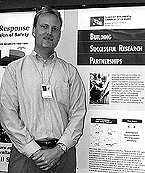
| T H E N I H C A T A L Y S T | N O V E M B E R – D E C E M B E R 1999 |
|
|
|
|
by
Beth Andrews |
TDCB: LINKING NIH AND INDUSTRY LABS
 |
|
Tom
Stackhouse, TDCB tech development and patent specialist
|
Collaboration between NIH scientists and non-NIH laboratories and organizations—to conduct research together or share research materials—often involves complex intellectual property issues and invariably requires negotiating agreements best handled by a separate, specially constituted body. At NIH, the Technology Development and Commercialization Branch (TDCB) is such an entity.
Housed within NCI but designated as a Competitive Service Center, the TDCB provides such technology transfer services for NCI and nine other NIH institutes (see "Roster" below). Its work is called "technology transfer" because it aids the transfer to private industry of technologies or discoveries made by federal scientists that are ripe for further development, commercialization, and, ultimately, distribution to the public.
Collaborative research, involving the exchange of information and resources between NIH and industry, is often part of the technology transfer process and is the type of activity TDCB supports. Collaborative research between the federal government and industry is effected by any of several technology transfer agreements—such as a Cooperative Research and Development Agreement (CRADA)—and often leads to inventions that are patented and licensed. The actual patenting and licensing of NIH inventions are managed by NIH’s Office of Technology Transfer (OTT).
Benefits of CRADA participation for NIH investigators include access to additional laboratory resources and the opportunity to work with industry scientists and to influence the direction of research that is heading toward commercialization.
An example of a successful CRADA is the collaboration between NCI and Bristol-Myers Squibb in the development of Taxol (paclitaxel), one the most active anticancer agents discovered in the past two decades. By the CRADA’s end, three inventions had been patented and licensed—and more than 29,000 patients had been treated. Taxol has been approved for five indications, including refractory ovarian and breast cancers.
The CRADA is but one type of agreement. Others used to facilitate collaborative research include:
—Material Transfer Agreement (MTA): to obtain (or provide) research materials, such as cell lines, cDNAs, and new pharmaceutical compositions, from outside organizations
—Clinical Trial Agreement (CTA): to transfer of research materials from outside organizations for use in NCI-sponsored clinical trials
—Confidential Disclosure Agreement (CDA): to effect the free exchange of confidential research information with an outside party while ensuring control over public disclosure
In addition to negotiating various types of collaborative agreements, TDCB is using market research, the World Wide Web, publications, and exhibiting at conferences and professional meetings to inform potential research partners in the pharmaceutical and biotechnology industries of NIH scientists’ discoveries and opportunities for joint research projects.
Closer to home, TDCB also
reviews employee invention reports and makes recommendations to OTT concerning
filing of domestic and foreign patent applications. ![]()
|
The TDCB is a designated Competitive Service Center (CSC) for technology transfer and offers full technology transfer services ranging from consultation to managing all IC technology development projects. Currently, the TDCB serves NCI and nine other client institutes:
For ICs not listed
above, TDCB can direct interested parties to the appropriate technology
development coordinator. For more information about technology transfer
or TDCB’s services, call 496- 0477, or visit the web
site.
|